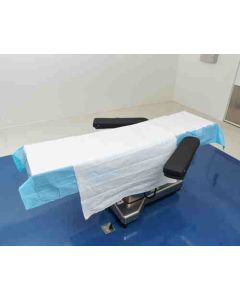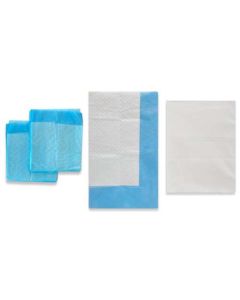Hospitals should select medical protective apparel based on safety and efficiency. Due to the large amount of healthcare-acquired infections, it is important to fully protect all medical equipment and personnel against the transmission of pathogens. This is especially critical in the operating theatre, where infection control is a challenge due to the constant flow of patients and staff.
It is crucial to select apparel that protects the surgical team and equipment from biological fluids while also being comfortable to wear. This raises the question: What are the benefits of single-use products versus reusable products in the operating theatre?
The selection of medical textiles is important for healthcare facilities in terms of benefits and costs, especially when the patients’ and surgeons’ lives are at stake.¹
Barrier Protection
One of the most important criteria for textiles in the operating environment is barrier protection. Without this, there would be no reason to wear a gown or to drape a patient. Textiles can either be reusable or disposable (single-use and non-woven).²
A European study concluded that disposable surgical textiles have a higher resistance to microbial penetration than reusable textiles. This study also highlighted that reusable products showed a lower liquid resistance than required in critical areas.²
Disposable gowns not only help protect staff but they also help reduce the transmission of pathogens and bacteria to the patient. If a table cover or gown is improperly laundered after a surgery, it can still contain microorganisms that can be transferred to a new patient. This can possibly result in an infection.
Single-use disposable textiles are manufactured in a sterile environment and packed in PE bags, making it impossible for them to be exposed to any pathogens prior to the operation.
Environmental Impact
It is a common belief that single-use, disposable textiles negatively affect the environment compared to reusable textiles. However, this is not truly the case when considering some points.
Reusable linens consume approximately 4.5 times more resources than single-use disposable products, mainly because of the water needed for laundering.5 Chemicals used during the laundry process can also be harmful to the flora when expelled into the sewage system. In terms of fabric production, one study showed that both types of textiles have a similar impact on the environment. On the one hand, single-use garments’ main materials are man-made and produced with oil, which contributes to a reduction in natural resources. On the other hand, cotton harvesting for manufacturing reusable textiles usually requires the use of pesticides.
Furthermore, the disposal of single-use products is a source of concern. But according to new research, there are many opportunities for long-term strategies and green initiatives with disposable textiles. One of them is the use of pelletised garment waste as a replacement for coal in power plants and other combustion applications.5
Lint and Other Airborne Particles
Lint and other airborne particles are a growing concern within the operating theatre. To facilitate the patient’s healing process, it is imperative to limit the presence of foreign particles. Reusable drapes and gowns produce small lint fibres that separate from the surface of the cloth during processing. This micro-debris could get into surgical wounds, contaminating them and potentially causing complications.
While it is impossible to eliminate 100 per cent of lint and other airborne particles, it is however possible to significantly reduce them. A study done in 2013 showed that single-use textiles made of polypropylene and worn during surgery had significantly lower colony-forming units than reusable textiles made of a mixed cotton and polyester material.4
Performance
Reusable cotton or synthetic gowns may reduce clinical waste, but they do start to deteriorate over the time. After manufacture, the fabric is at its strongest and meets the required standards. However, it can break down through repeated use and laundering, and the level of protection can decrease. This means that at any given point in the gown or drape’s life, the barrier protection level can be lower than when it was originally purchased.
In comparison, single-use drapes and gowns are always used at their highest level of quality, so the barrier protection is consistent. Using reliable materials in the operating environment helps maintain an optimal level of safety.
Laundering
Safety of your staff and patients is certainly something to consider when deciding between single-use and reusable gowns, drapes and table linens in your healthcare facility. But infection control practitioners also have to take the risks of the laundry personnel into consideration. They process hundreds of thousands of kilograms of contaminated reusable linens annually and can be at risk for injury if precautions are not taken.³
Table linens generally contain bodily fluids and other harmful bacteria and could pose a transmission risk for employees if not handled properly. With disposable linens, there is no need to wash the contaminated items; therefore, there is no risk for laundry personnel.
References
¹ American Journal of Infection Control, Application of cost/benefit analysis for surgical gown and drape selection: A case study, available at: http://www.ajicjournal.org
² https://textlnfo.files.wordpress.com/2013/03/reusable-vs-disposable.pdf
³ Infection Control Today, Lessons in Linen - Following Aseptic Technique in the Laundry Department, available at: http://www.infectioncontroltoday.com
4 National Center for Biotechnology Information, Single-use surgical clothing system for reduction of airborne bacteria in the operating room., available at: https://www.ncbi.nlm.nih.gov/pubmed/23694760
5 The Mcilvaine Company, A White Paper on Performance, Cost Per Use, and Environmental Impact of Single-Use and Reusable Surgical Gowns & Drapes, available at: http://www.mcilvainecompany.com
QuickSuite® is a kit that contains a variety of disposable components to easily and efficiently set up and clean up the operating table before and after surgery. The kit includes:
- Sahara OR Table Sheet
- Armboard covers
- Headboard covers
- Lift sheet.
Different kit compositions are available for different types of procedures, and components can also be ordered separately.
VIDEO
Watch Our Video about QuickSuite
Promote Patient and Staff Safety
- Reduce moisture and prevent skin breakdown with the absorbent layer.
- Reduce cross-contamination risks with the disposable design.
- Prevent linting thanks to the components’ sealed edges.
- Transfer the patient safely and easily using the lift sheet.
Improve Operating Theatre Efficiency
- The table is protected from bacteria thanks to the impervious layer of the Sahara Sheet.
- Operating theatre turnover time is reduced as clean-up is easier.
Reduce Costs
- There are no laundry costs to manage.
Related Products



